
Holyoke is a city in Hampden County, Massachusetts, United States, that lies between the western bank of the Connecticut River and the Mount Tom Range. As of the 2020 census, the city had a population of 38,247. Located 8 miles (13 km) north of Springfield, Holyoke is part of the Springfield Metropolitan Area, one of the two distinct metropolitan areas in Massachusetts.

Holyoke Heritage State Park is history-oriented state park located in the city of Holyoke, Massachusetts. The park opened in 1986 on the site of the William Skinner Silk Mill which was lost to fire in 1980. The park is managed by the Massachusetts Department of Conservation and Recreation.

The Holyoke Canal System is a system of power canals in Holyoke, Massachusetts. It is split into three canals based on elevation and distance from the inlet at the Holyoke Dam- the First Level Canal, Second Level Canal, and Third Level Canal. Constructed over a period between 1847 and 1892, the Canal System, along with the Dam, is recognized as a Historic Mechanical Engineering Landmark by the American Society of Mechanical Engineers for its use in the development of the Venturi meter by Clemens Herschel, the first means of measuring large-scale flows, and the McCormick-Holyoke Turbine by John B. McCormick, which doubled the efficiency of turbines to more than 80% in its time.
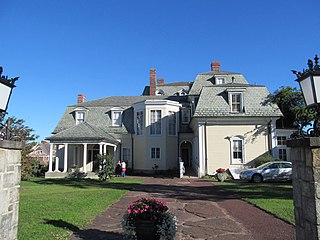
Wistariahurst is a historic house museum and the former estate of the Skinner family, located at 238 Cabot Street in Holyoke, Massachusetts. It was built in 1868 for William Skinner, the owner of a successful silk spinning and textile business, and is named for the abundant wisteria vines which cascade across its eastern facade. Originally constructed in Williamsburg in 1868, the mansion designed by Northampton architect William Ferro Pratt was moved to Holyoke in 1874, following the devastating flood which swept away the original Skinner mills. Following the death of Belle Skinner, its music room was operated as a private museum from 1930 to 1959, housing the Belle Skinner Collection of Old Musical Instruments, before their donation by the family to Yale University. Since 1959 it has been operated as the Wistariahurst Museum, and is open to the public. The property was listed on the National Register of Historic Places in 1973.

This article addresses the history of papermaking in Massachusetts.

Holyoke High School is a public high school in Holyoke, Massachusetts, United States. Since 2015, the school, along with the district, has been in state receivership and through a series of changes in practices, such as innovative restorative justice disciplinary programs, has seen marked improvement in student retention and graduation rates. In the 2017-2018 school year Holyoke High received higher combined SAT scores than the average for schools in Boston, Worcester, and Springfield.

PeoplesBank is the largest community bank in Western Massachusetts, providing banking and other financial services. As of 2020 it had $3.3 billion in assets.

Steiger's was a department store company of New England in the 19th and 20th centuries. Founded in Holyoke, Massachusetts in 1896, its flagship store for much of the company's history was in Springfield, Massachusetts. At the time of its purchase by May Department Stores, Steiger's was described as the last family-owned chain of department stores in New England.

Doing business as D. H. & A. B. Tower, brothers David Horatio Tower and Ashley Bemis Tower were internationally known American architects, civil and mechanical engineers based in Holyoke, Massachusetts, who designed mills and factories in the United States from Maine to California as well as abroad, including in Canada, Mexico, Germany, Brazil, the United Kingdom, India, China, Japan, and Australia. By the time of its dissolution, the firm was described by one contemporary account as "the largest firm of paper mill architects in the country at that time"; its files reportedly contained more than 8,000 architectural plans for sites, mill machinery, and waterpower improvements.

Oakdale is a neighborhood in Holyoke, Massachusetts located to the west of the city center, adjacent to downtown. Developed as a streetcar suburb in the late nineteenth century, today the neighborhood contains many Victorian houses, and about 460 acres (190 ha) of mixed residential and commercial zoning, as well as Forestdale Cemetery, Saint Jerome Cemetery, Rohan Park, and Holyoke Medical Center.

Holyoke Medical Center, formerly known as Holyoke City Hospital, is a full-service, community and regional non-profit medical center located in Holyoke, Massachusetts. Holyoke Medical has 198 beds in the main hospital and runs a comprehensive healthcare system that includes the VNA, River Valley Counseling Center and Western Mass Physician Associates, a physician practice group. The service area for hospital covers Greater Holyoke area, with towns in both Hampshire and Hampden County including Holyoke, Chicopee, South Hadley, Granby, Easthampton, Southampton, West Springfield, and Belchertown.
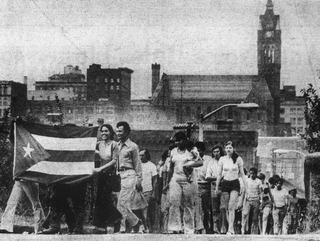
As of the 2010 census, Holyoke, Massachusetts had the largest Puerto Rican population, per capita, of any city in the United States outside Puerto Rico proper, with 47.7% or 44,826 residents being of Puerto Rican heritage, comprising 92.4% of all Latinos in the community. From a combination of farming programs instituted by the US Department of Labor after World War II, and the housing and mills that characterized Holyoke prior to deindustrialization, Puerto Ricans began settling in the city in the mid-1950s, with many arriving during the wave of Puerto Rican migration to the Northeastern United States in the 1980s. A combination of white flight as former generations of mill workers left the city, and a sustained influx of migrants in subsequent generations transformed the demographic from a minority of about 13% of the population in 1980, to the largest single demographic by ancestry in a span of three decades.
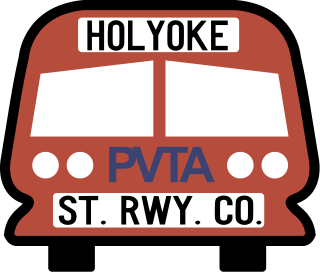
The Holyoke Street Railway (HSR) was an interurban streetcar and bus system operating in Holyoke, Massachusetts as well as surrounding communities with connections in Amherst, Belchertown, Chicopee, Easthampton, Granby, Northampton, Pelham, South Hadley, Sunderland, Westfield, and West Springfield. Throughout its history the railway system shaped the cultural institutions of Mount Tom, being operator of the mountain's famous summit houses, one of which hosted President McKinley, the Mount Tom Railroad, and the trolley park at the opposite end of this funicular line, Mountain Park.

During the late 19th and early 20th centuries Holyoke saw an influx of Franco-Americans, predominantly French-Canadians, who immigrated to Massachusetts to work in the city's growing textile and paper mills. By 1900, 1 in 3 people in Holyoke were of French-Canadian descent, and a 1913 survey of French Americans in the United States found Holyoke, along with other Massachusetts cities, to have a larger community of French or French-Canadian born residents than those of New Orleans or Chicago at that time. Initially faced with discrimination for the use of their labor by mill owners to undermine unionization, as well as for their creation of separate French institutions as part of the La Survivance movement, this demographic quickly gained representation in the city's development and civic institutions. Holyoke was at one time a cultural hub for French-Canadian Americans; the Saint-Jean-Baptiste Society of America was first organized in the city in 1899, along with a number of other institutions, including theater and drama societies from which famed vaudevillian Eva Tanguay was first discovered, and regular publications, with its largest French weekly newspaper, La Justice, published from 1904 to 1964. The city was also home to author Jacques Ducharme, whose 1943 book The Shadows of the Trees, published by Harper, was one of the first non-fiction English accounts of New England's French and French-Canadian diaspora.
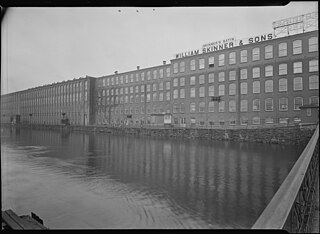
William Skinner & Sons, generally sold under the names Skinner's Satin, Skinner's Silk, and Skinner Fabrics, was an American textile manufacturer specializing in silk products, specifically woven satins with mills in Holyoke, main sales offices in New York, and a series of nationwide satellite offices in Boston, Chicago, Philadelphia, Baltimore, Cincinnati, Cleveland, Minneapolis, Rochester, and St. Louis. Founded in 1848 by William Skinner as a partnership between himself and his brother-in-law at that time, the company was first established at a long-term location in Haydenville in 1854, as the Unquomonk Silk Mills. Following the Mill River Flood of 1874, Skinner relocated both his home and company to new facilities in Holyoke, Massachusetts, where the company would maintain its mills for the remainder of its existence. By the 20th century, Skinner & Sons had become the largest manufacturer of satins in the world, becoming one of the first to directly market to consumers in 1903, and operated out of the largest silk mill under one roof by 1912. During the 1920s and 1930s the brand was popularized with its usage in Hollywood, with silk gowns made from its satins adorned by such stars as Joan Crawford and Bette Davis on the silver screen. The company would also work extensively with the US Armed Forces during the Second World War, developing improved silk and other textile parachutes. Following a period of decline due in part to an increasingly competitive world market, the Skinner family and other shareholders sold the company for an undisclosed amount on January 26, 1961 to Indian Head Mills, which continued to operate the mills for converting rayon and other synthetics until the closure of the plant as a textile mill in 1963. In the 1970s, the Finished Goods Division of Indian Head was acquired by Springs Global, which used the Skinner name, marketing, and product line until the late 1980s; it has been defunct since that time.
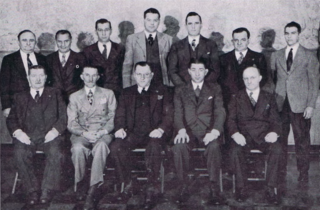
Despite representing a significantly smaller population than their Irish, French, Polish, or Puerto Rican counterparts, in the late 19th century through the mid-20th century, German immigrants predominantly from Saxony and Rhineland played a significant economic, cultural, and political role in the history of Holyoke, Massachusetts. The influx of these immigrants can largely be attributed to a single mill and millworker complex, the Germania Woolen Mills, which formed the basis of the immigrant colony that would make the ward encompassing the South Holyoke neighborhood that with the highest German population per capita, in all of New England by 1875. Along with unionization efforts by the Irish community, Germans would also play a key role in the city and region's socialist labor movements as workers organized for higher pay and improved living conditions in the textile and paper mill economies.

From the beginning of the city's history as the western bank of Springfield, Irish families have resided in and contributed to the development of the civics and culture of Holyoke, Massachusetts. Among the first appellations given to the city were the handles "Ireland", "Ireland Parish", or "Ireland Depot", after the village was designated the 3rd Parish of West Springfield in 1786. Initially occupied by a mixture of Yankee English and Irish Protestant families, many of whom belonged to the Baptist community of Elmwood, from 1840 through 1870 the area saw a large influx of Irish Catholic workers, immigrants to the United States, initially from the exodus of the Great Famine. During that period Irish immigrants and their descendants comprised the largest demographic in Holyoke and built much of the early city's infrastructure, including the dams, canals, and factories. Facing early hardships from Anti-Irish sentiment, Holyoke's Irish would largely build the early labor movement of the city's textile and paper mills, and remained active in the national Irish nationalist and Gaelic revival movements of the United States, with the Holyoke Philo-Celtic Society being one of 13 signatory organizations creating the Gaelic League of America, an early 20th century American counterpart of Conradh na Gaeilge.

The Children's Museum at Holyoke is a children's museum in Holyoke, Massachusetts, featuring participatory art, exhibits related to science, daily life, and an elaborate climbing area. The museum is located Downtown, within Holyoke Heritage State Park, in the renovated Sheldon Building of the former William Skinner and Sons silk mill complex.
As of the 2010 United States Census, there were 39,880 people, 15,361 households, and 9,329 families residing in the city of Holyoke, Massachusetts. The population density was 723.6/km2 (1,874/mi²). There were 16,384 housing units at an average density of 277.2/km2 (718.6/mi²).






































